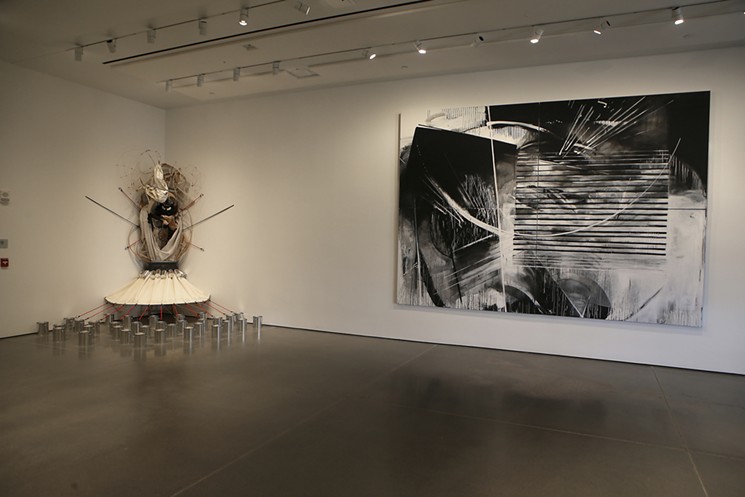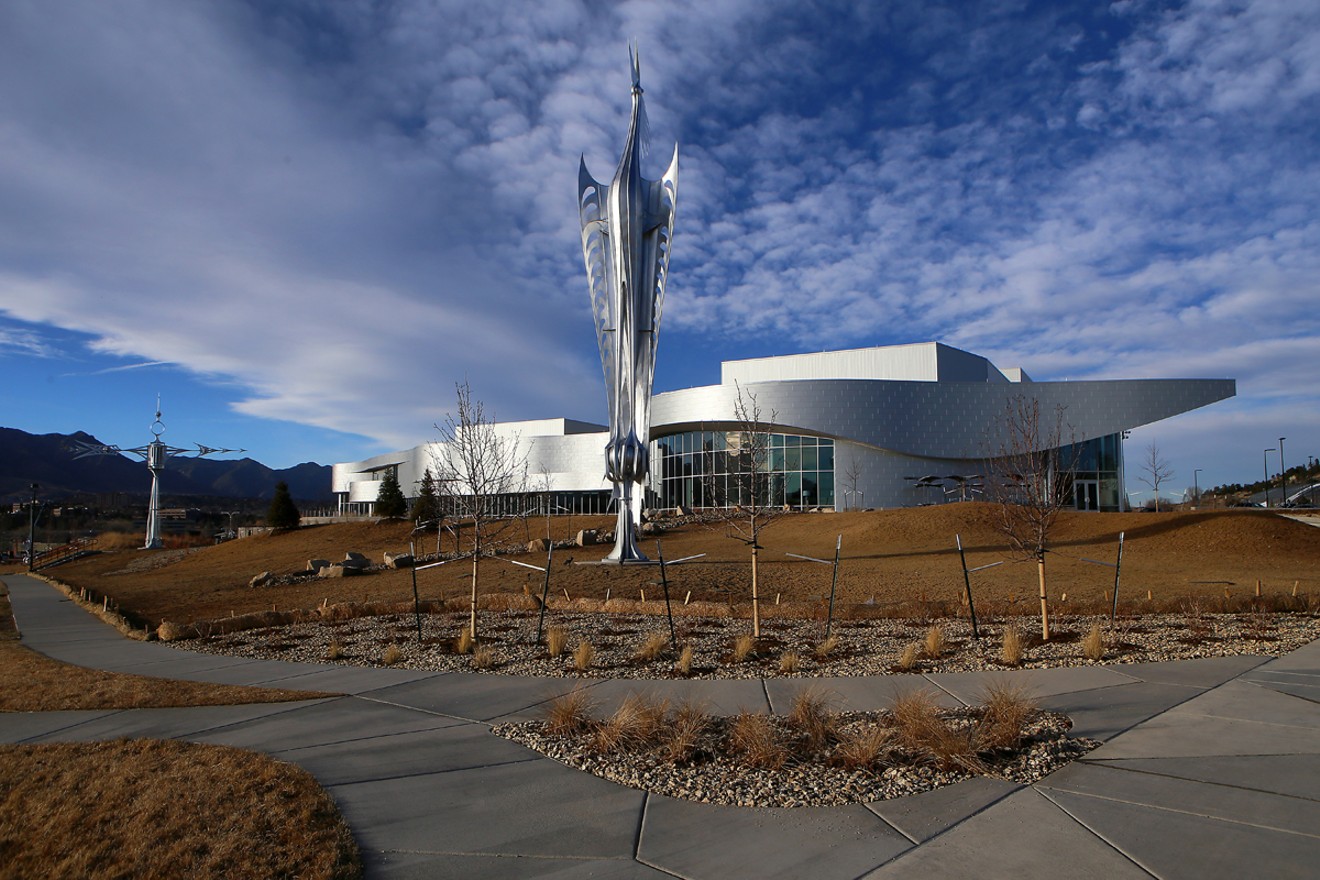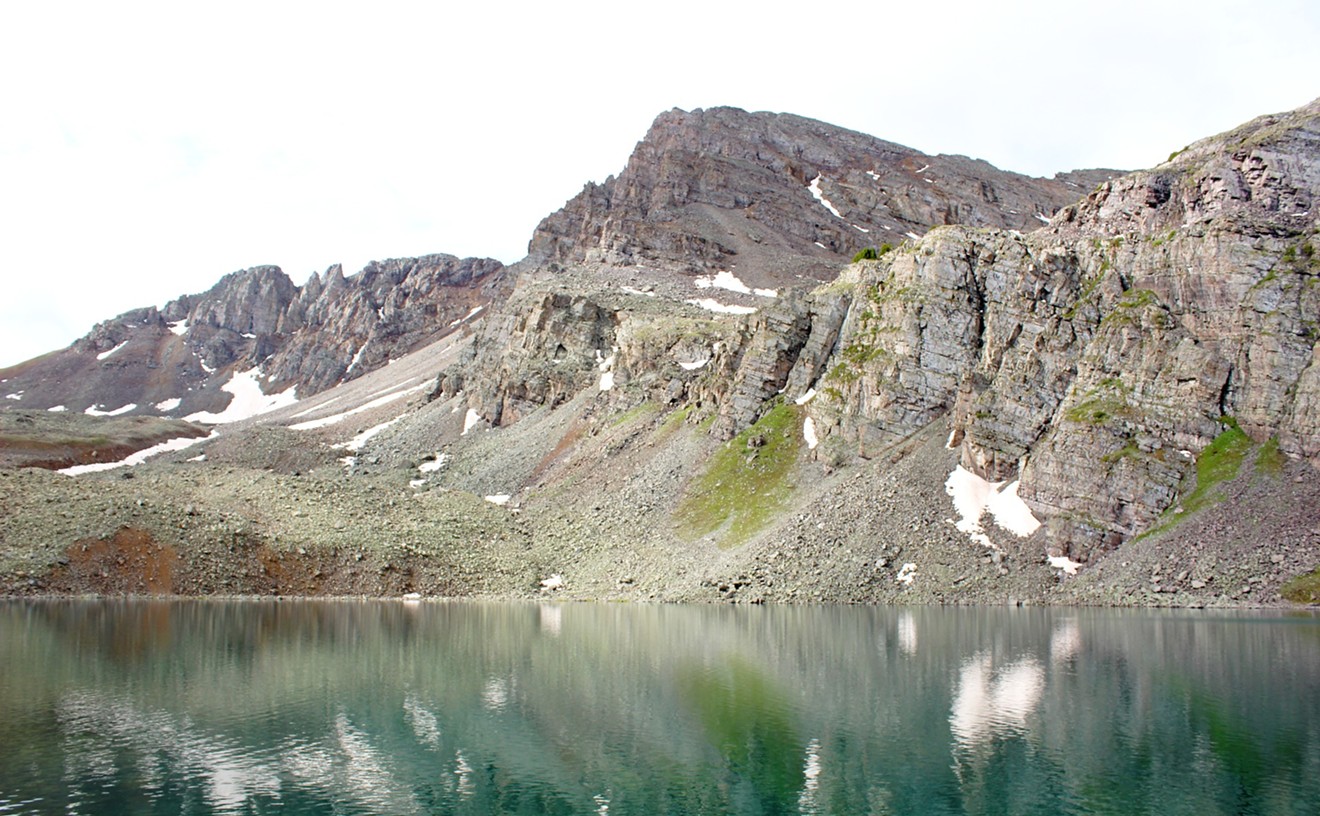The 92,000-square-foot building sits on a rise above the busy intersection of North Nevada Avenue and Austin Bluffs Parkway. This is at the extreme southwestern corner of the campus, its most high-profile site in terms of traffic, and the Ent Center deserves the attention. Created by Denver’s Semple Brown Design together with New York’s H3 Hardy Collaboration Architecture, a specialist in the design of arts centers, the structure was conceived as an exaggerated horizontal with an undulating, south-facing facade of enormous curving glass walls and shiny silver cladding that looks like titanium but is actually a composite. The wave-like undulations are in conversation with each other, swooping in and out, above and below. A contrasting approach is seen on the north-facing rear side, where the internal volumes of the building bump up and out in a cubic conception. But that continuous facade in front sets the building’s futuristic tone.
The site design, which also incorporated an existing arroyo, was conceived by Denver’s Davis Partnership, and the landscaping was done by Tapis Associates of Colorado Springs. The topography of the campus is extreme, ranging from steep hills to the even steeper bluffs beyond them, and this spot at the bottom of the hills presented challenges. Without some major land resculpting, the Ent Center would be coming up out of the ground on the lower side, so the dirt from the excavations for the foundation was piled up in front. The fill was then turned into terraces held in place by curvilinear walls mirroring the curved elements on the building. The plantings are native grasses, bushes and trees. There are stairs and meandering walkways leading around the structure and up to several monumental sculptures that have turned the lawn into a full-fledged sculpture garden.
I walked around and through the Ent Center with Daisy McGowan, director of the Galleries of Contemporary Art that are housed in the building and in a satellite space downtown. She assembled the sculptures on view outside, most of which are on temporary, two-year loans through an initiative called Art WithOut Limits. But they could — and should — be made permanent fixtures.
The standouts are a trio of remarkable metal spires, two with kinetic features, set in a regular rhythm across the lawn. These pieces look so contemporary and are so in keeping with the building’s character, you’d think they were custom-made — but the artist, the legendary Starr Kempf, died nearly 25 years ago. Also compelling is Linda Fleming’s large, linear sculpture near the street at the bottom of the hill, in which bands of rusting steel outline a sphere with arching legs. According to McGowan, in a few months one of Fleming’s pierced-screen sculptures will be installed at the top, close to the building. Both Kempf and Fleming have long been recognized as masters of Colorado art.

The Shockley-Zalabak Theater at the Ent Center for the Arts.
Courtesy of the University of Colorado Colorado Springs
The main entrance at the southeast corner of the building leads into the grand Murray and Betty Ross Lobby, which has curved window walls that take in the majestic views of Pikes Peak; it’s clear that the architects placed the walls to frame the stunning views. The lobby feeds into the very impressive Shockley-Zalabak Theater, which seats nearly 800, has a full-fledged fly-house over the stage and boasts adjustable panels on the ceiling that can be tuned acoustically. Facilities for music, theater and dance take up most of the interior; other performance spaces include the Chapman Foundations Recital Hall, reserved for classical music, and the Dusty Loo Bon Vivant Theater, home to the resident TheatreWorks troupe. There are also rehearsal halls, studios and workshop rooms for UCCS classes.

"Homage to Senga," mixed materials, and "Untitled 111," acrylic on canvas, both by Floyd D. Tunson.
Tom Kimmell

(Left to Right) "Synchromesh 49," mixed materials, "Untitled 142" and "Untitled 141," both acrylic on canvas, all by Floyd D. Tunson.
Tom Kimmell
Tunson was an inspired choice to introduce the new Sharpe gallery — and, by extension, the Ent Center itself. With this show and the Kempfs and the Fleming outside, the place is virtually a master class in Colorado art.
Floyd D. Tunson: Janus, through April 15, Ent Center for the Arts, 5225 North Nevada Avenue, Colorado Springs, 719-255-8227, galleryuccs.org.












